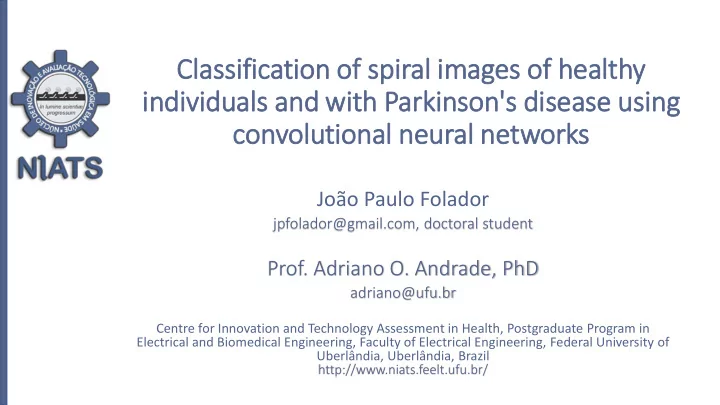

Cla lassification of f spiral im images of f healthy in individuals and wit ith Park rkinson's dis isease usin ing convolutional neural networks João Paulo Folador jpfolador@gmail.com, doctoral student Prof. Adriano O. Andrade, PhD adriano@ufu.br Centre for Innovation and Technology Assessment in Health, Postgraduate Program in Electrical and Biomedical Engineering, Faculty of Electrical Engineering, Federal University of Uberlândia, Uberlândia, Brazil http://www.niats.feelt.ufu.br/
Núcleo de Inovação e Avaliação Tecnológica em Saúde Parkinson’s disease 2
Motivation • Parkinson's disease (PD) is present in about 1% of the world's population over 65 years, and still remains incurable. Núcleo de Inovação e Avaliação • PD is a disease that has a difficult diagnosis. Tecnológica em Saúde • Know the various symptoms is the key to the correct diagnosis and understanding of the disease. • Techniques involving Artificial Intelligence have been applied to aid in the detection of symptoms, and techniques involving deep learning have achieved more expressive results than traditional techniques. 3
Data collection • The Research Ethics Committee of the Federal University of Núcleo de Inovação e Avaliação Uberlândia approved the research under the number 07075413.6.0000.5152. Tecnológica em Saúde Group Total Sex (F/M) Age (years) Health 12 8/4 60,08 ± 6,13 PD 15 7/8 65,33 ± 9,17 4
Data collection • Original drawings done by the participants Núcleo de Inovação e Avaliação • First, the participant followed the model of Tecnológica em Saúde Archimedes' spiral and then performed the drawing freely • The images were scanned and preprocessed (Gimp software was used in this step) 5
Data collection • Each individual drew about 3 (three) or 4 (four) Núcleo de Inovação e Avaliação spirals • The spirals were resized Tecnológica em Saúde to width and height of 256 x 256 pixels. • 51 images was collected from each group, totalizing 102 images. 6
Convolutional Neural Network (C (CNN) Núcleo de Inovação e Avaliação Tecnológica em Saúde 1: Input image of Convolutional Neural Network 2: Convolution layer that yields the feature maps 3: Pooling layer is used to dimensionality reduction 4: The Fully connected layer represents a vector with all features to classify the images (it looks like a multilayer perceptron network - MLP) 5: The last layer has one neuron (unit) to classify between two kinds of classes 7
Example of f a CNN Núcleo de Inovação e Avaliação Tecnológica em Saúde 8 Reference: https://developer.nvidia.com/discover/convolutional-neural-network
Data augmentation original A technique to increase the data , there is the increase of the number of Núcleo de Inovação e Avaliação rotation samples modifying the original sample and then apply it in CNN Tecnológica em Saúde • Rotation ( rotation_range=20° ) • Vertical flipping ( vertical_flip=true ) • Shear ( shear_range=0.2 ) vertical • Horizontal shifting ( width_shift_range=0.2 ) flipping • Zoom ( zoom_range=0.2 ) • Rescale ( rescale=1./255 ) zoom 9
Development environment • API Keras, a library to explore the machine learning techniques • Program language Python 3.5 Núcleo de Inovação e Avaliação • TensorFlow 1.2, a engine to work with machine learning Tecnológica em Saúde • The CPU and GPU process all the calculus in parallel by the library CUDA from NVidia • Intel i7 2.4 GHz + 8 GB RAM DDR 3 + Video board de 2GB Nvidia GT 650 10
Núcleo de Inovação e Avaliação Tecnológica em Saúde 75% training and 25% validation Results 11
Results Accuracy is expected to measure how well the test predicts both categories Núcleo de Inovação e Avaliação Specificity the ability of the system to accurately predict the absence of the condition for cases that do not actually have it. Tecnológica em Saúde Nº of Average Steps per Time Test Epochs convolution validation Specificity epoch spent (s) layers accuracy 1 100 10 2 73.4 % 62.0 % 64 2 200 10 2 75.2 % 60.4 % 158 3 800 10 2 78.9 % 64.8 % 727 4 1000 10 2 78.0 % 59.8 % 1854 12
Results 90.00% 2000 1854 78.90% 78.00% 1800 75.20% 80.00% 73.40% Núcleo de Inovação e Avaliação 1600 70.00% 64.80% 62.00% 60.40% 59.80% 1400 60.00% Tecnológica em Saúde 1200 50.00% 1000 40.00% 800 727 30.00% 600 20.00% 400 10.00% 200 64 158 0.00% 0 1 2 3 4 Average validation accuracy Specificity Time spent (s) 13
Discuss and conclusion • The classic configuration of CNN obtained a satisfactory classification (average of 76.3%) in the identification of healthy Núcleo de Inovação e Avaliação individuals and Parkinson's disease spirals. • Larger data volume is required to perform other tests and get Tecnológica em Saúde better results • We need refine the network parameters, test other error calculation functions other than the mean squared error, etc . • Test another architecture CNNs • A simple CNN network with few images brought a satisfactory result illustrating the high performance of the Deep Learning techniques 14
Acknowledgements Núcleo de Inovação e Avaliação Tecnológica em Saúde Thank you! CAPES - Programa CAPES / DFATD-88887.159028 / 2017-00 FAPEMIG-APQ-00942-17 A. O. Andrade é Bolsista de Produtividade do CNPq, Brasil (304818/2018-6 e 305223 / 2014-3) 15
Cla lassification of f spiral im images of f healthy in individuals and wit ith Park rkinson's dis isease usin ing convolutional neural networks João Paulo Folador jpfolador@gmail.com, doctoral student Prof. Adriano O. Andrade, PhD adriano@ufu.br Centre for Innovation and Technology Assessment in Health, Postgraduate Program in Electrical and Biomedical Engineering, Faculty of Electrical Engineering, Federal University of Uberlândia, Uberlândia, Brazil http://www.niats.feelt.ufu.br/
Recommend
More recommend